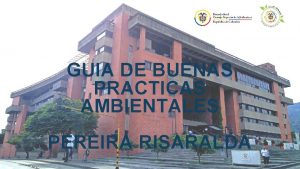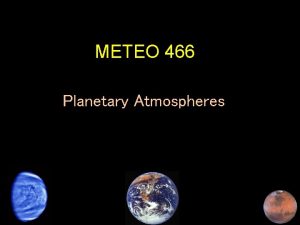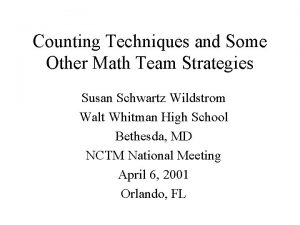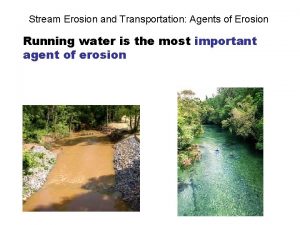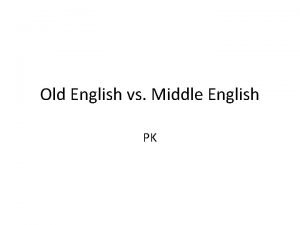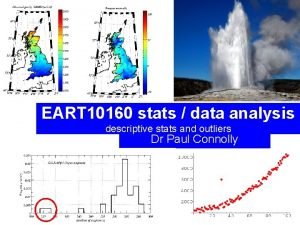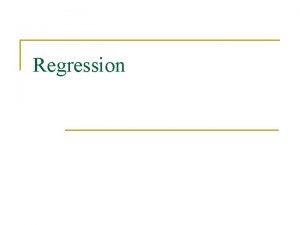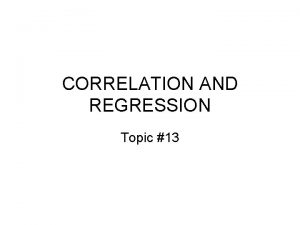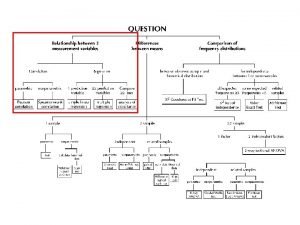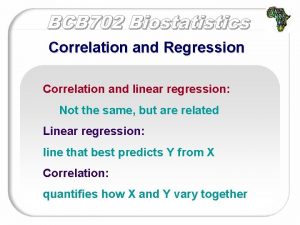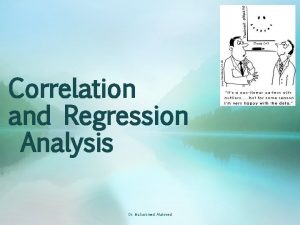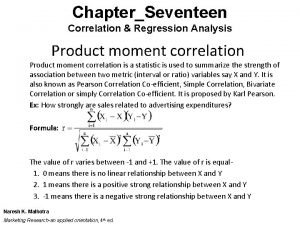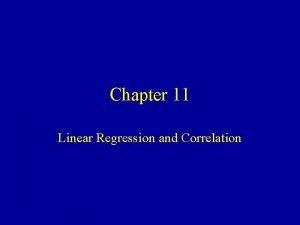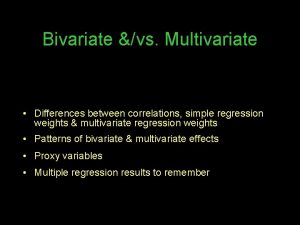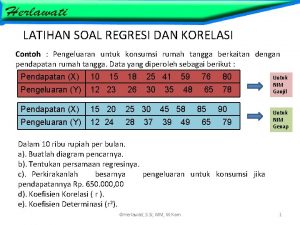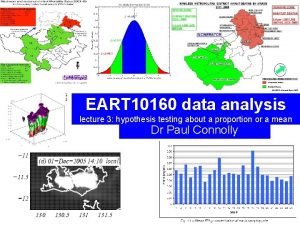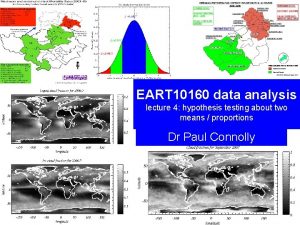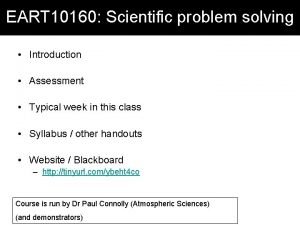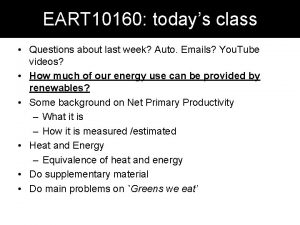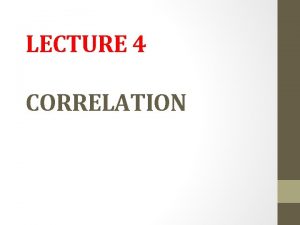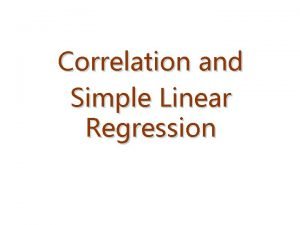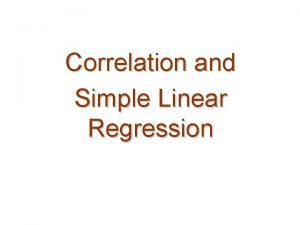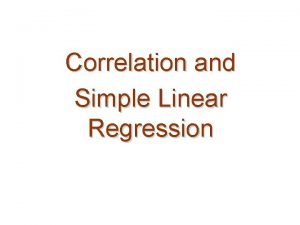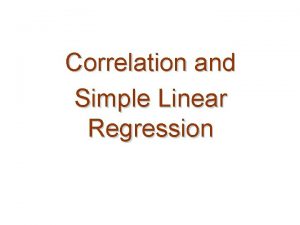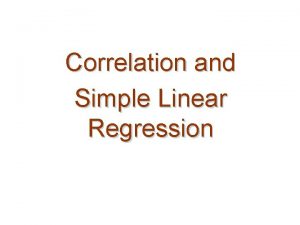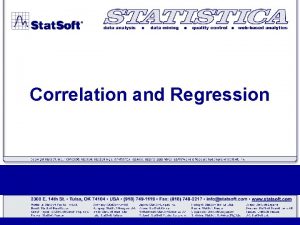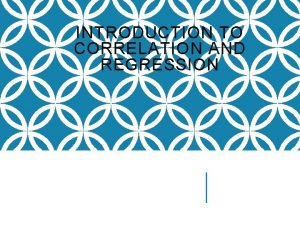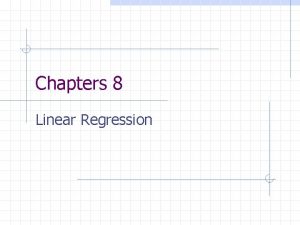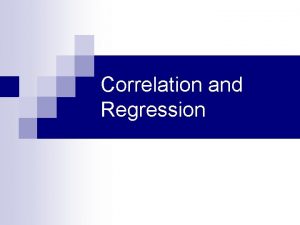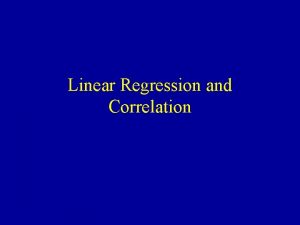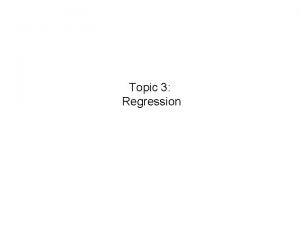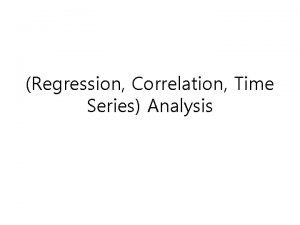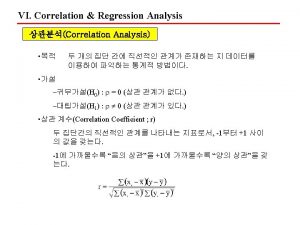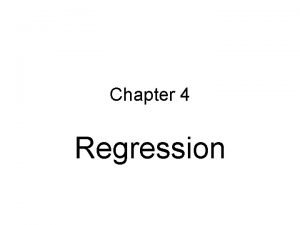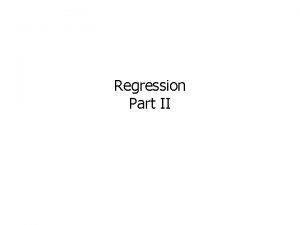EART 10160 data analysis lecture 10 Correlation regression


























- Slides: 26

EART 10160 data analysis lecture 10: Correlation, regression and error propagation Dr Paul Connolly

Intended learning outcomes • Know how to assess how well variations in one variable can be used to explain variations in another. • Fit straight lines and curves to data – Mathematics I am afraid! • Test the hypothesis that your correlation coefficients are real. • Error propagation.

Definitions • The sample correlation coefficient, – symbol r. • The population correlation coefficient, – symbol r.

Definition - correlation coefficient • Some values of r: y r = +1 Perfect positive correlation y x r = -1 y x Perfect negative correlation r=0 No correlation x Ouch! Good we don’t need to know it MATLAB: corrcoef(x, y) Or corr 2(x, y) can be used Excel: =correl(range 1, range 2)

Definition - correlation coefficient • • r 2 is the amount of variation in x and y that is explained by the linear relationship. It is often called the `goodness of fit’ E. g. if an r = 0. 97 is obtained then r 2 = 0. 95 so 100 x 0. 95=95% of the total variation in x and y is explained by the linear relationship, but the remaining 5% variation is due to “other” causes. r 2, fraction of explained variation It is sometimes important to assess whether the correlation could have occurred by chance => hypothesis test. 1. 0 0. 9 0. 8 0. 7 0. 6 0. 5 0. 4 0. 3 0. 2 0. 1 0. 0 +1. 0 +0. 5 +0. 0 -0. 5 Correlation coefficient, r -1. 0

Methodology: • State the null and alternate hypotheses: – E. g. H 0: r=0, H 1: r≠ 0 • Calculate a statistic (to be defined): something that if null hypothesis is true is distributed according to a theoretical distribution. • Calculate a critical value from theoretical distribution. • Assess which is largest: statistic or critical value and • Accept the null if statistic < critical value or reject the null (and hence accept the alternate) if statistic > critical value.

Why does this kind of hypothesis testing work? • Statisticians have found that if you take a random sample of quantitative data, size n, from a population and then another independent sample size n, then calculate the correlation coefficient, r… • will be: – Distributed according to a t-distribution (if the data are drawn from the same population), with n-2 degrees of freedom • Therefore, if we calculate a value of t from our data that is large, we can say it is unusual.

One-tailed and two-tailed tests • When testing hypotheses of the correlation coefficient we usually only use the twotailed test – E. g. CO 2 levels vs temperature have a correlation coefficient that is different to 0. – If we take limited data sizes we can get high correlation coefficients.

Correlation: CO 2 vs temperature Question is, given there is only a small amount of data here, is the correlation coefficient significant?

Correlation: rain vs terrain: is rainfall correlated to terrain?

Does chocolate make you clever?

Fitting straight lines Calculate the correlation coefficient, r, and the standard deviation of y and x Calculate the mean of x and the mean of y Heat added to 1 litre of water, Q … … Change in temperature, DT …. . . could be the heat it takes to heat up the apparatus (e. g. kettle filament, etc).

So fitting log of the drop number at time t against t will give a straight line with an intercept of log of N 0 and a slope of –J. Ndrop … … t …. . . log(Ndrop) t … …

So fitting log of the terminal velocity against log of diameter D will give a straight line with an intercept of log of a and a slope of b. v … … D …. . . log(v) … … Are particles sedimenting due to Stokes’ law: • non turbulent, v=a. D 2 or are they in a turbulent flow regime: • v=a. D 0. 5 log(D) … …

Error propagation



Final answer

Practical: lidar data within clouds that I’ve worked on as part of my research

Question was how much water-ice is present in Martian clouds?

Data were taken by the Phoenix Lander on Mars The mission responded to evidence returned from NASA's Mars Odyssey orbiter in 2002 indicating that most high-latitude areas on Mars have frozen water mixed with soil within arm's reach of the surface The vertical green line in this illustration shows how the weather station on Phoenix will use a laser beam from a lidar instrument to monitor dust and clouds in the atmosphere.

Airborne measurements on Earth Ozonesondes (profiles) ARA Egrett, 10 - 15 km NERC Dornier 0 -5 km

Sampling method: • Grob Egret: sampled cirrus clouds in-situ. • Measurements: Particle microphysics, turbulence, water vapour, temperature, IR fluxes. • Kingair: remotely sensed cirrus clouds from below by airborne LIDAR.

Australian clouds… Use regression between measured ice water content to extinction in Earth’s clouds and apply this to Martian clouds. Fly through the clouds with aircraft and sample them

Well-trained eye: note that when you see this much data falling close to a straight line, it is pretty clear that the correlation is going to be statistically significant • Log of ice water content versus log of extinction is a straight line. Watch out for `base’ of logarithm! This implies a power law

For fitting a power law such as: IWC=Ax. Extb It could be that you fitted a power law, for example your input was log(x) and log(y) and you fitted a straight line. In this case, after fitting your straight line, you would have to calculate A=exp(a) and b=b
 Psaa14-10160
Psaa14-10160 Positive correlation versus negative correlation
Positive correlation versus negative correlation Negative and positive correlation
Negative and positive correlation Goole earth
Goole earth Ray nimmo
Ray nimmo Meteo eart
Meteo eart Eart
Eart Googol eart
Googol eart Genesis 11 1-9 nkjv
Genesis 11 1-9 nkjv Eart
Eart Thy thou thee old english
Thy thou thee old english Eart meaning
Eart meaning Difference between regression and correlation
Difference between regression and correlation R squared to correlation coefficient
R squared to correlation coefficient Pearson correlation coefficient
Pearson correlation coefficient Regression vs correlation
Regression vs correlation Coefficient of correlation
Coefficient of correlation Difference between regression and correlation
Difference between regression and correlation Correlation and regression
Correlation and regression Absolute value of correlation coefficient
Absolute value of correlation coefficient Multivariate vs bivariate
Multivariate vs bivariate Contoh soal regresi
Contoh soal regresi Linear regression vs multiple regression
Linear regression vs multiple regression Linear model regression
Linear model regression Survival analysis vs logistic regression
Survival analysis vs logistic regression Logistic regression vs linear regression
Logistic regression vs linear regression Polynomial regression least squares
Polynomial regression least squares
